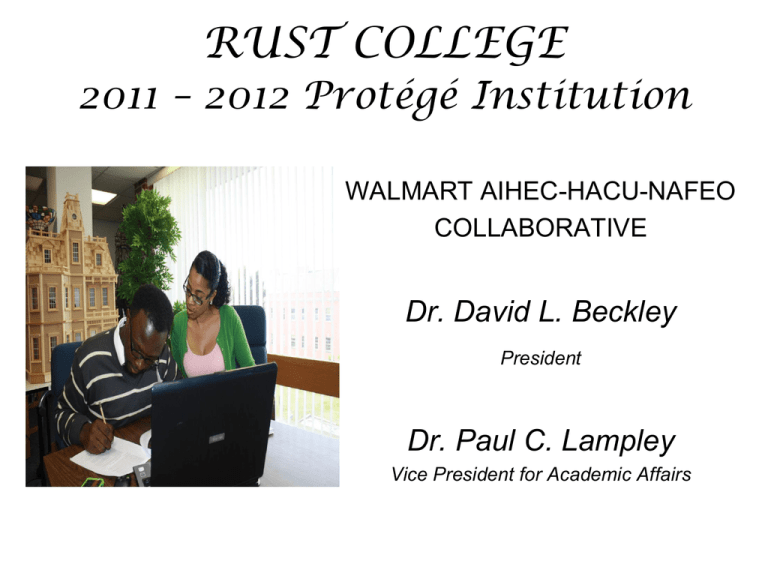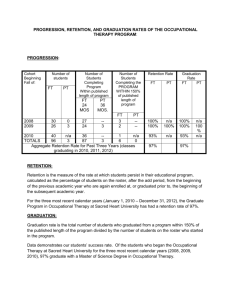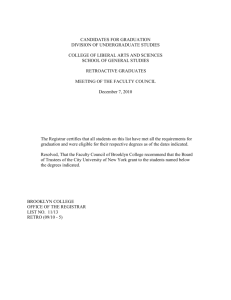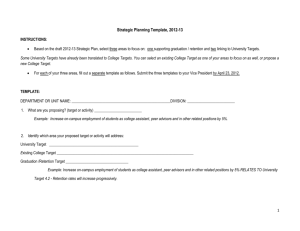Rust College - MSI Student Success
advertisement

RUST COLLEGE 2011 – 2012 Protégé Institution WALMART AIHEC-HACU-NAFEO COLLABORATIVE Dr. David L. Beckley President Dr. Paul C. Lampley Vice President for Academic Affairs RUST COLLEGE’S MISSION STATEMENT • Rust College is a historically Black, coeducational, senior liberal arts college founded in 1866 by the Freedman’s Aid Society of the Methodist Episcopal Church. The College is related to the United Methodist Church, and dedicated to serve students with a variety of academic preparations, through instruction in the humanities, social and behavioral science, natural sciences, business, technology and education. Fee Schedule 2011-2012 Tuition Room & Board Total $8,100.00 $3,700.00 $11,800.00 Fall 2010 – Total Enrollment (All Undergraduate ) Attendance Status Student Race Ethnicity Student Gender Undergraduate Student Age Undergraduate Student Residence RUST COLLEGE WILEY COLLEGE (Protégé) (Mentor) Similar Characteristics Past & Current Relationships *Presidents* Organizational Chart First Year Experience 2010-2011 Vice President For Academic Affairs First Year Experience Director Administrative Assistant Counselors (2 Full Time) Student Support Service Director Administrative Assistant Student Success Center Coordinator Counselor & Retention Coordinator Career Services Director FYE Student Resource Model • Early Warning System • Student Support Services Grades First FYE Student • • Cope Center Freshman Advisors • • • Required Grade-Point-Average (Most Recent two Years) • Retention and Graduation Rates • Divisional Retention Advisors First Year Experience Student The purpose of the FYEP is to further the goals of Rust College by providing a quality program of general education which meets the needs of students at different levels of ability and academic preparation. Early Warning System – The Early Warning system (EWS) is a computer-based program collecting first year students’ absences and tardiness on a daily basis. Grades First – Retention management system that gathers information in real-time at the “point of instruction.” It enables schools to identify at-risk students and prioritize services for their benefit. Male Mentor Program – Male students paired with a faculty or staff counselor. Academic and personal concerns discussed on a regular basis. Cope Center – The COPE Center is to aid in student retention. It helps students to identify emotional, mental health and personal challenges that my interfere with retention. Student Support Services is aimed to increase retention and graduation rates of eligible students, and foster and institutional climate supportive of the success of low income and first generation college students and individuals with disabilities. Graduation by Major 2007-2011 2007 2008 2009 2010 2011 9 11 7 5 7 12 10 17 10 16 Mass Communication/Print Journalism 1 2 1 3 0 Sociology 6 3 7 5 4 English/Political Science* 0 0 1 0 0 Political Science 5 12 5 4 7 Social Science 0 2 0 1 2 Music 1 1 1 0 1 Bachelor of Arts English Mass Communication/Broadcast Journalism 2007 2008 6 4 9 6 10 Business Administration 18 10 13 21 18 Biology 30 24 26 42 26 7 3 6 4 2 11 17 10 10 8 Computer Science/Mathematics* 0 1 0 0 0 Mathematics 1 0 1 3 3 Biology Education 0 0 0 0 0 English Education 0 1 0 0 1 Elementary Education 0 3 1 0 4 Bachelor of Social Work 2009 2010 2011 Bachelor of Science Chemistry Computer Science Bachelor of Science 2007 2008 2009 2010 2011 Child Care Management/Early Childhood Education* 0 0 6 7 8 Health & Leisure Management 0 0 0 0 1 Biology/Chemistry* 7 1 3 4 1 Math Education 1 0 0 0 0 Health Physical Education and Recreation 0 1 0 0 0 Social Science Education 0 1 1 1 0 Computer Science/Music* 0 0 1 0 0 15 14 3 4 3 0 0 0 0 0 1 0 Child Care Management Medical Technology Social Science Mathematics/Biology 1 Associate of Science 2007 2008 2009 2010 2011 Business Administration 1 1 3 0 0 Early Childhood Education 7 7 2 5 8 138 126 124 126 131 Total Institutional Research 121709 Graduation Rates Total Student Body 2004 - 2009 Bachelor's First-time, Full-time degree-seeking undergraduate students. New students who transferred from other colleges are not included. Entering Year Fall 2004 Fall 2005 Fall 2006 Fall 2007 Fall 2008 Fall 2009 # % # % # % # % # % # % 1 Entering Cohort 288 X 273 X 256 X 331 X 350 X 379 X 2 Number of students from Line 1 who returned for a 2nd year 158 55% 152 56% 181 71% 231 70% 226 65% 255 67% 3 Number of students from Line 1 who returned for a 3rd year 114 40% 116 42% 148 58% 152 46% 149 43% X X 4 Number of students from Line 1 who returned for a 4th year 99 34% 102 37% 121 47% 108 33% X X X X 5 Number of students from Line 1 who returned for a 5th or 6th year 82 28% 85 31% 67 26% X X X X X X 6 Number of students from Line 1 who graduated in 4 years (or less) 42 15% 36 13% 53 21% 51 15% X X X X 7 Number of students from Line 1 who graduated in 5 years or less (include line 6) 73 25% 64 23% 73 29% X X X X X X 8 Number of students from Line 1 who graduated in 6 years or less (include those from Lines 6,7 & 8) 80 28% 79 29% X X X X X X X X Graduation





